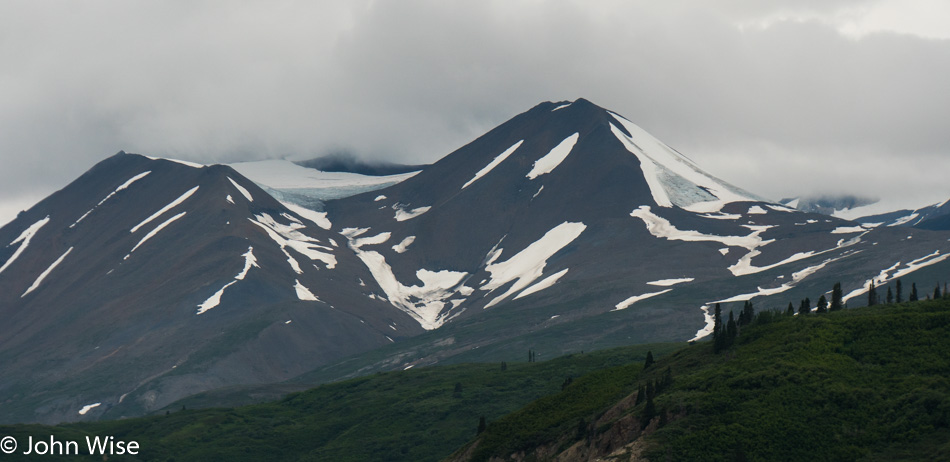
It rained overnight, but by morning, it’s dry again, though we have a pretty healthy amount of cloud coverage. Our gear is packed up and ready to go by 6:00, which might have been considered late by everyone ready to go yesterday at 5:30. The boatmen lightheartedly lament our efficiency because it puts pressure on them to get breakfast done and put in on the river early. Pauly is in the kitchen cooking up BBQ sausage, eggs, and potato scramble with toasted English muffins. Bruce is adding some air to the rafts to bring their pressure back up, while Thirsty tends the fire that is heating our dishwater. Before we push off, we have a bit of rain, but rain up here is to be expected. If it snowed, none of us would be surprised.
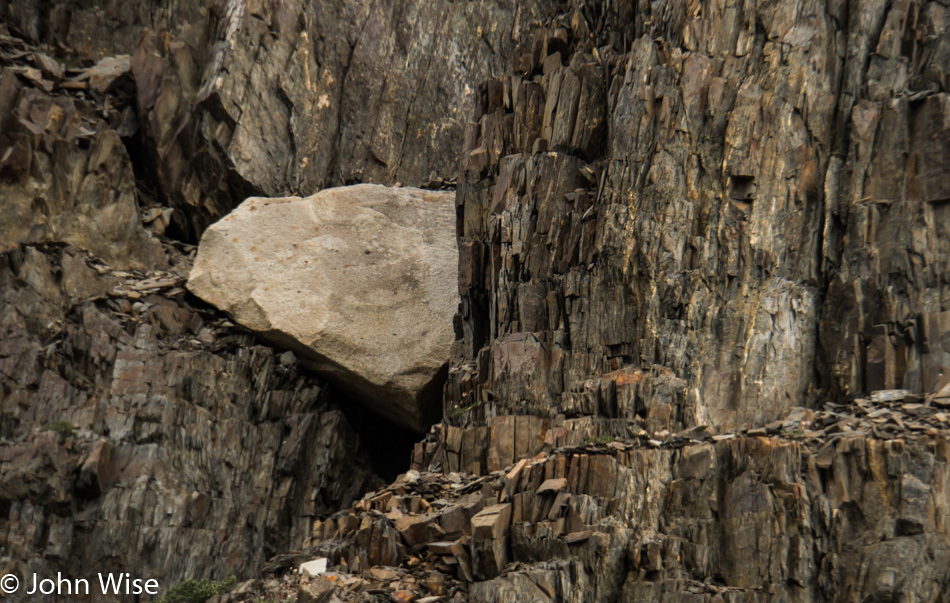
Back on the river, we continue to have some sporadic light rain as we paddle south. Passing a random cliff, Bruce points out this granite boulder among the rocks. It’s obviously out of place and is what is known as an “erratic.” These are remnants of a retreating glacier and are deposited as they roll off the ice. We spend the next hour looking for other erratics.
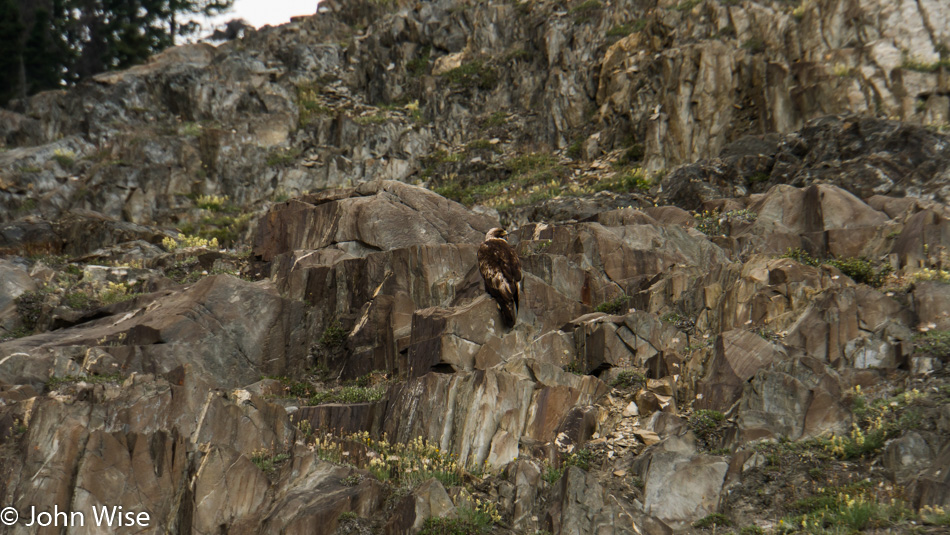
While scanning the landscape for erratics, we spot this juvenile bald eagle looking upriver. It didn’t appear interested in us in the least; I guess there’s something to be said for being one of the apex predators out here.
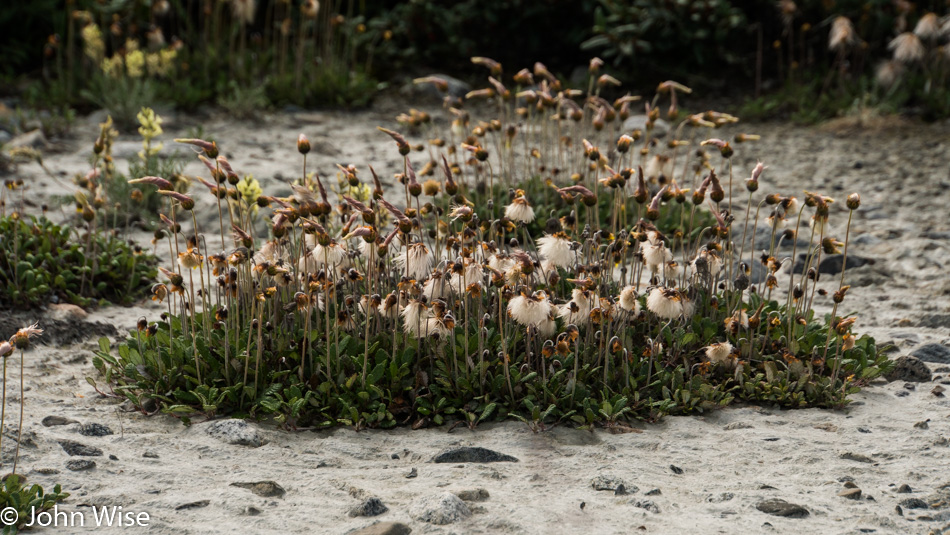
Mountain avens, also known as white dryas, seem to be everywhere along the river. What you don’t want to see this close and so frequently are bears. We were out here at the gas station, I mean, bend in the river, collecting firewood, when the raft that had been behind us pulled up and said they’d spotted a grizzly heading our way, that it was moving with purpose, and that we should too. I yelled at Caroline to get out of the thicket and make haste to return to the raft. With no further sign of the bear and confident that we had enough firewood, we were once again making our way down this flooded thoroughfare.
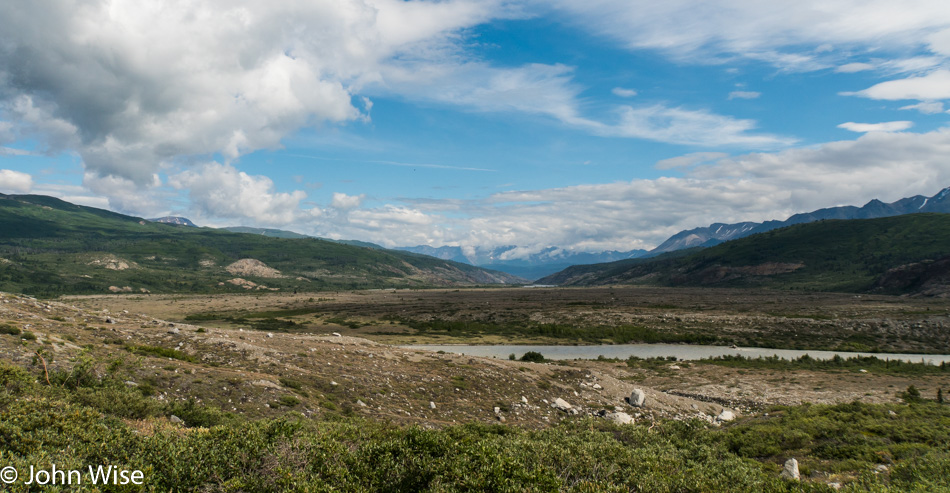
By the time we reached the left lateral moraine of the Lowell Glacier, the skies had been clearing for a while. This hike up the moraine held fond memories as it was from this area that we first saw the Lowell five years earlier.
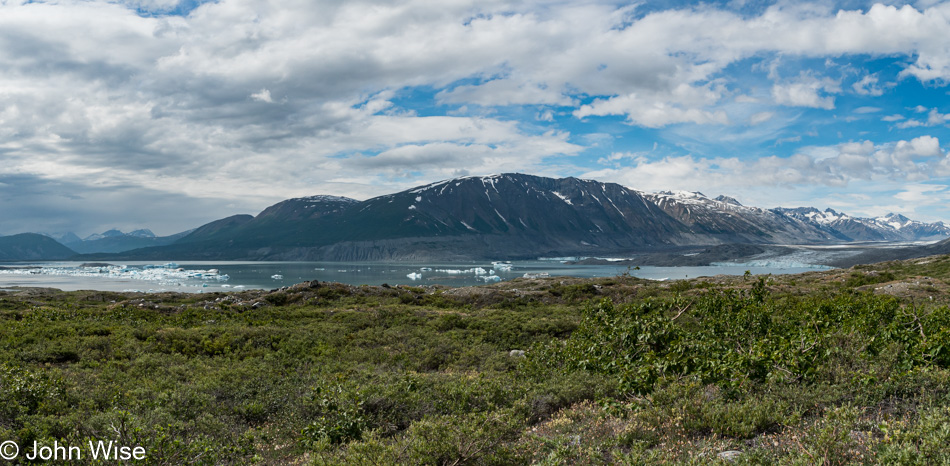
We were stunned as we crested the moraine to see a glacier that begged the question: what happened? Our guides Pauly and Thirsty, who’d been out here a couple of weeks before, said there had been no ice on the lake then, so at least we had some bergs now, but the retreat of the face of the glacier was huge in my memory. Upon getting home, I compared photos, and it was obvious that the ice was in retreat and thinning. The nunatak (a big rock solidly stuck within the glacier, also known as a glacial island) is also more visible and pronounced.
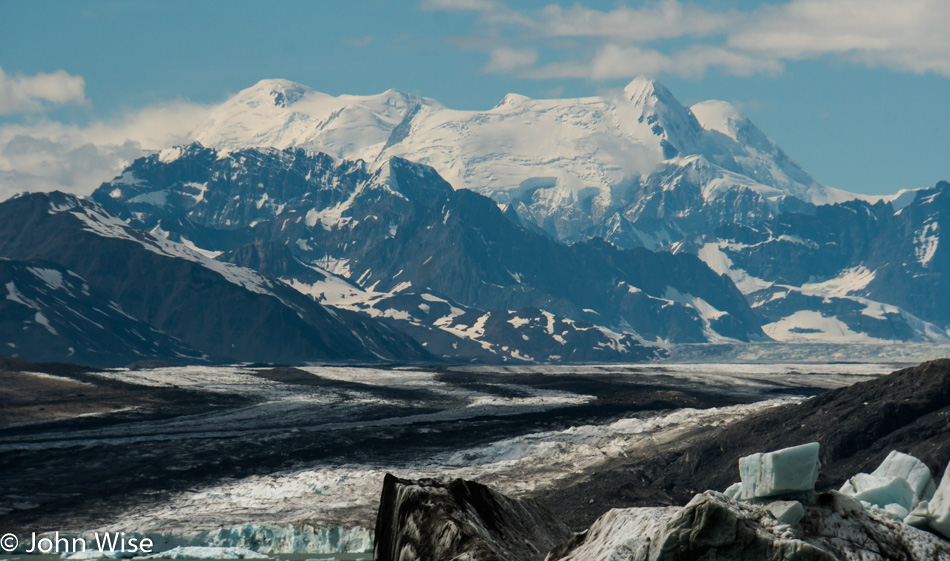
At the bottom left is the face of Lowell Glacier. Bottom right is some bergs in the lake and just behind them on the right is a small glimpse of the nunatak. That giant mountain in the background is Mount Kennedy, named after our very own President John Kennedy, and is a part of the Saint Elias mountains and still within Kluane National Park in the Yukon, Canada. The President’s brother, Robert Kennedy, holds the distinction of being the first person to ascend the peak back in 1965, the first and only serious mountain climbing he would ever do.
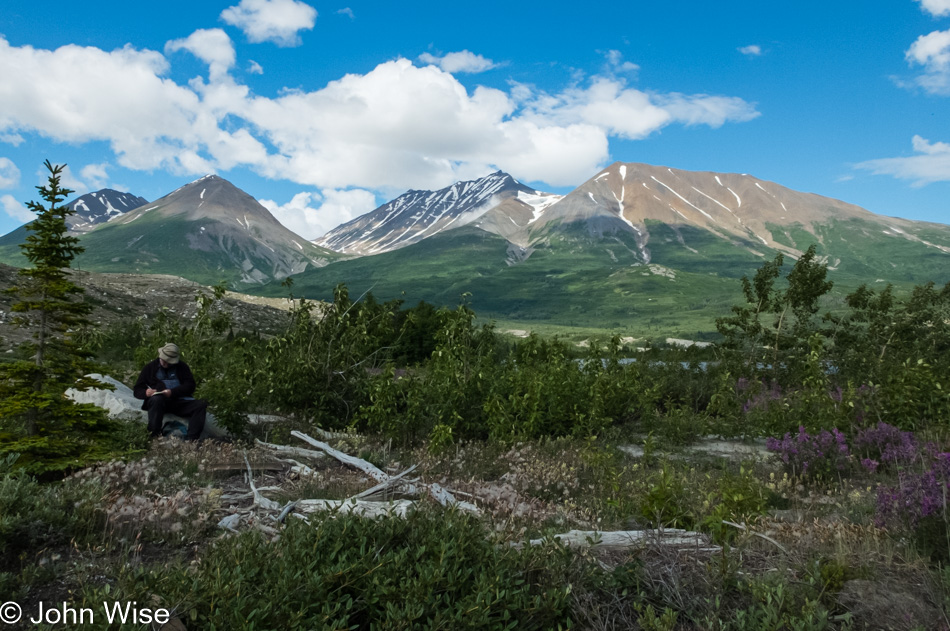
Now, back where we parked the boats, it was lunchtime and a moment for me to pull up a rock and jot a few things down in my notebook. Throughout a river trip, you’ll likely see me somewhere nearby doing just this.
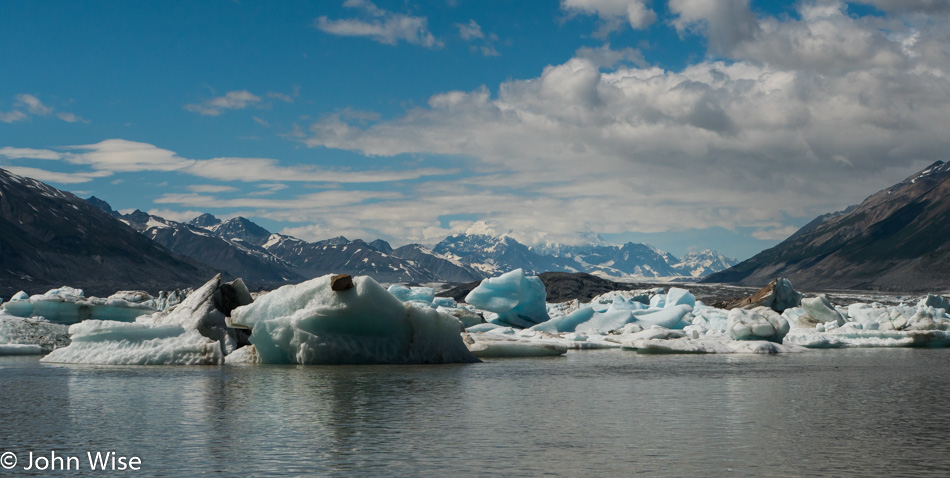
After lunch, we had some fast water and minor rapids to contend with before entering Lowell Lake. Water level, wind, and ice typically make the entry worrisome for boatmen as most anyone who’s been out here more than once usually has a story about paddling into the wind or pulling rafts through shallow water after hoping to avoid a portage so early on during a river trip. So, while the lake has considerably fewer icebergs than on our previous visit, lucky that it had icebergs at all, and the water level was high enough that it was smooth sailing.
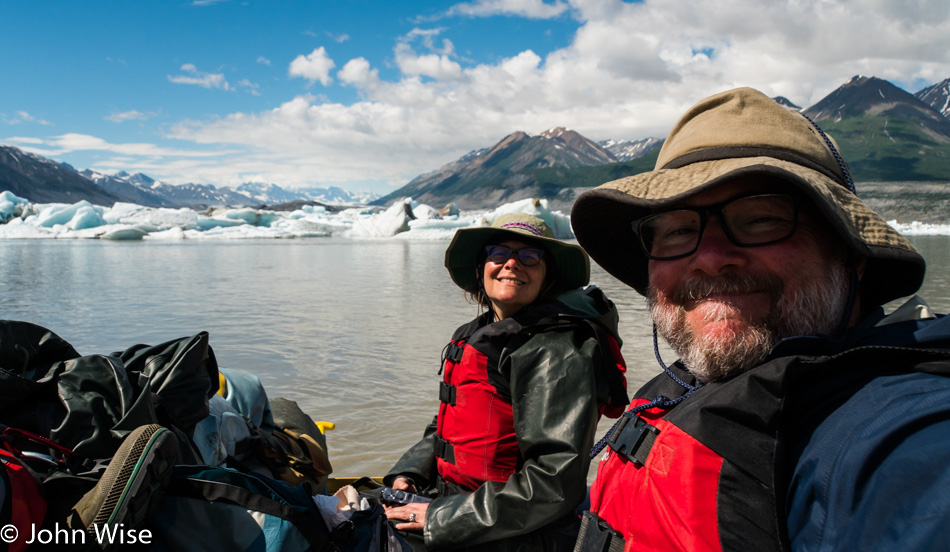
No selfie sticks were used in the production of these photos. If it weren’t for these photos of us in these kinds of environments we may not believe that we were here 20 years from now. Even while out here, there is a kind of ethereal, otherworldly nature where finding a distinction between dream state and reality is just a tiny bit tenuous. We constantly ask ourselves, “Are we really this lucky?”
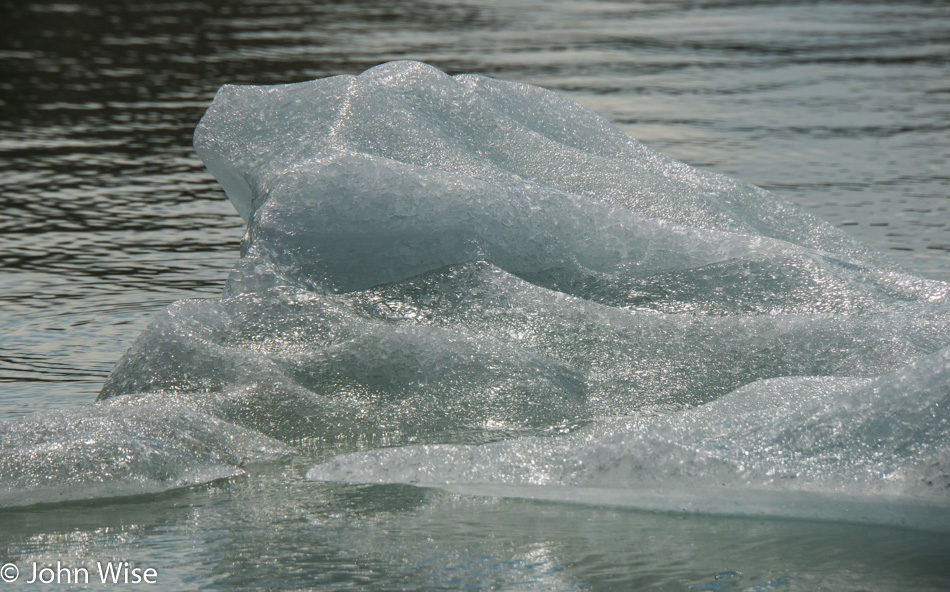
Detail of a small iceberg on its way to being an ice cube.
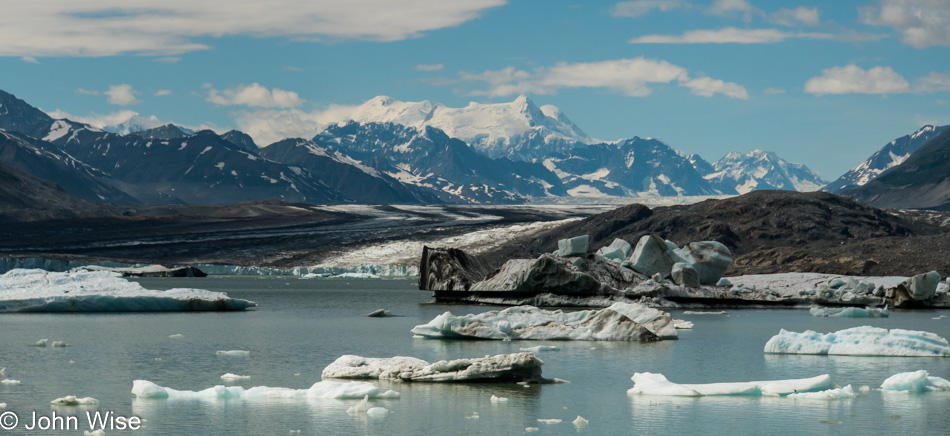
While the views are reminiscent of our previous visit to this remote corner of Earth, they bear repeating.
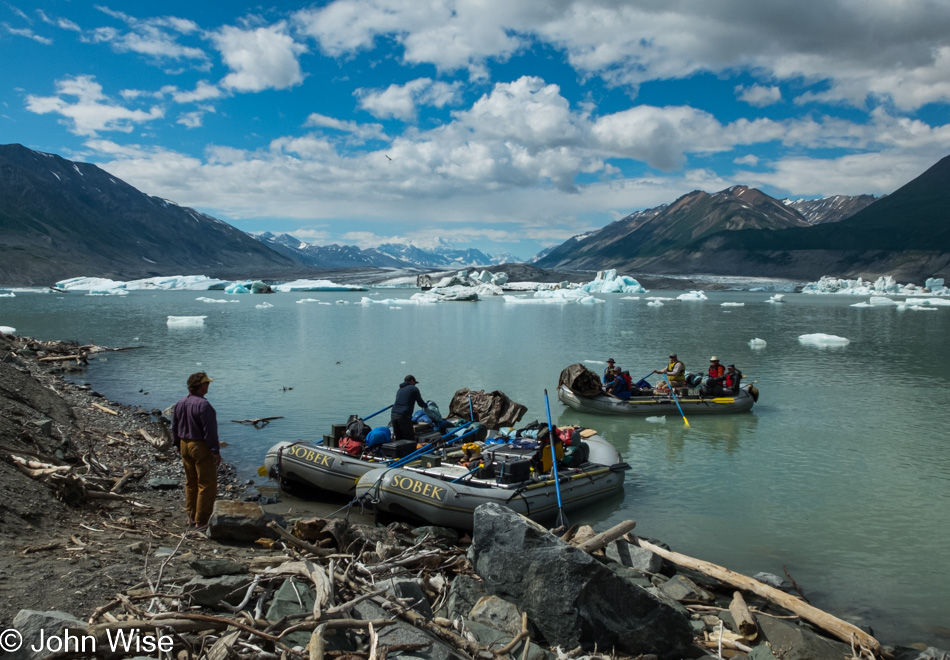
Pulling ashore to make camp is always exciting; this was made more so as it felt unbelievable that we’d occupy this small corner of such a vast landscape for a second time.
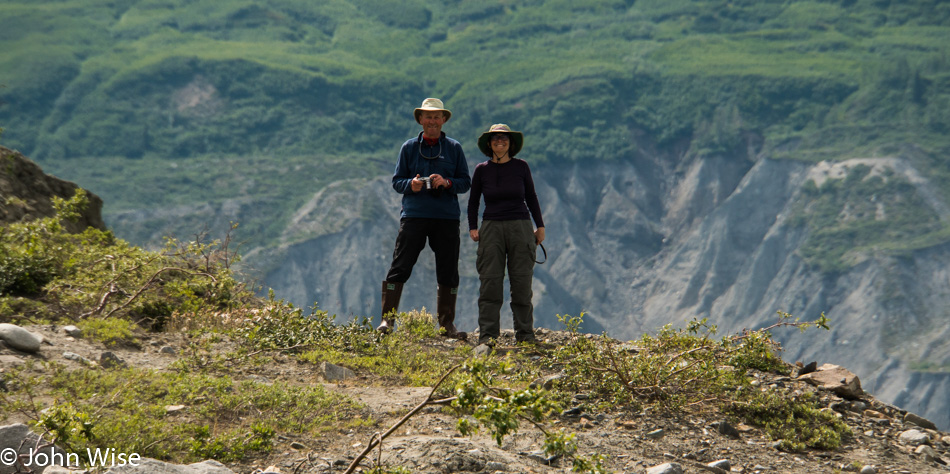
This is William “Willie” Mather and Caroline, who, until I got their attention, had been looking over Lowell Lake and further onto the glacier. We’d met Willie on a rafting trip on the Yampa back in 2014, and then a couple of years later, he was passing through Arizona, so Caroline took him on a hike up Camelback Mountain, which offers the most commanding views of Phoenix. Sadly, I couldn’t go as business wasn’t affording me the opportunity, but was able to catch up with the two of them for dinner at our favorite Mexican restaurant, “El Conquistador.” If there was one thing you should know about this guy, it is that he’s a hill walker, an avid hardcore walker who needs to be on the move. Someday, we hope to visit him at his home in County Angus, Scotland.
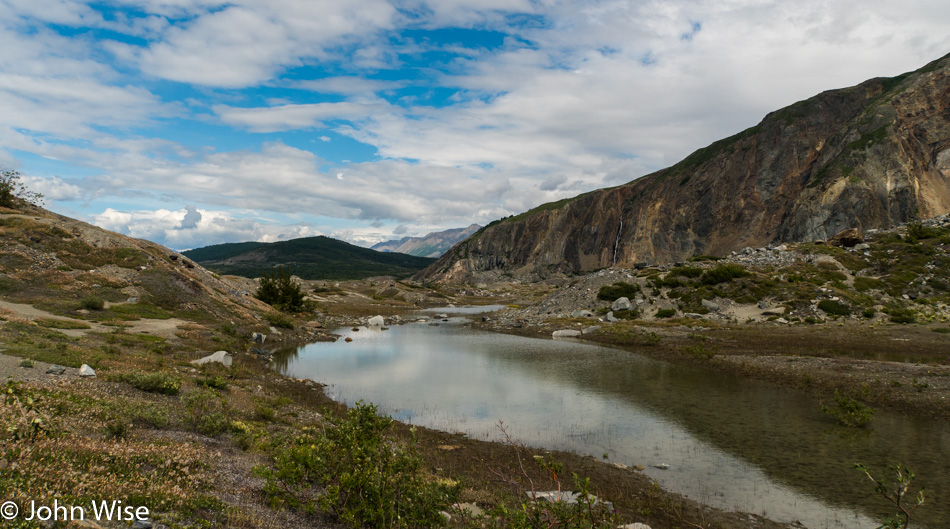
Same view from our tent site as on our visit five years ago. The beach where I bathed last time is underwater, and it’s getting so bright and hot that I’m finally giving in to putting on the sunscreen that my wife consistently nags me about. The weather is so nice that I break out my solar panel to start recharging the battery we are lugging around that runs my CPAP. I have sleep apnea, for those that don’t know what a CPAP is. A CPAP is a device that ensures I keep breathing during the night; yep, I’m out here doing this kind of stuff even though I have to remain tethered at night to a machine.
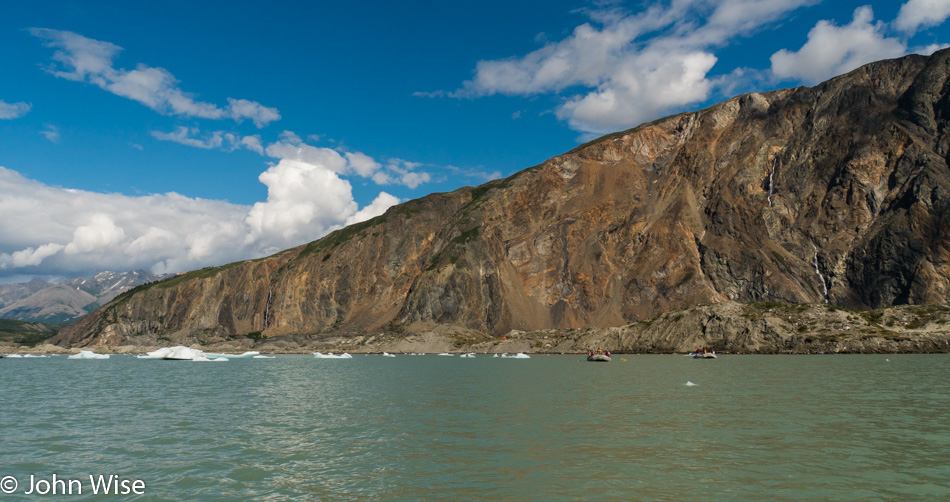
If you look closely, you might see the orange tent of our trip leader, Bruce Keller, over onshore. The other two rafts are to the right of the tent. With the camp, kitchen, and the unit set up, we were heading out on the lake in our inflatable cruise ships for a three-hour tour. Okay, so it wasn’t a three-hour tour, but I couldn’t resist the cultural reference to my childhood….you know, the Gilligan’s Island theme song???
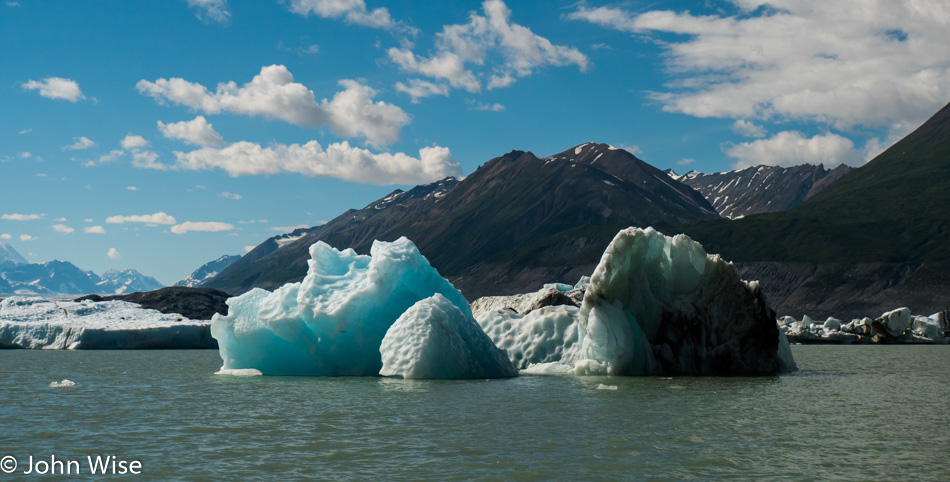
While there are not a lot of bergs, the ones that are here are monsterish enough to be extremely dangerous if we were too close when they roll over. Speaking of, we were lucky enough to see one rolling over in the distance. I don’t think we were out an hour, but close to it. I probably would have never been truly satisfied unless we rowed out to the face of the glacier for an up-close and personal encounter, but the boatmen assured me that it would take a couple of hours of rowing to reach the main body of the glacier and that it would be back-breaking work if the wind kicked up. The way I see it is that this then leaves another reason to come back for a third visit, though the wife is more interested in the Kongakut River for our next Alaska adventure. Come to think of it, I could probably be talked into considering a trip down the Hula Hula up in the Arctic.
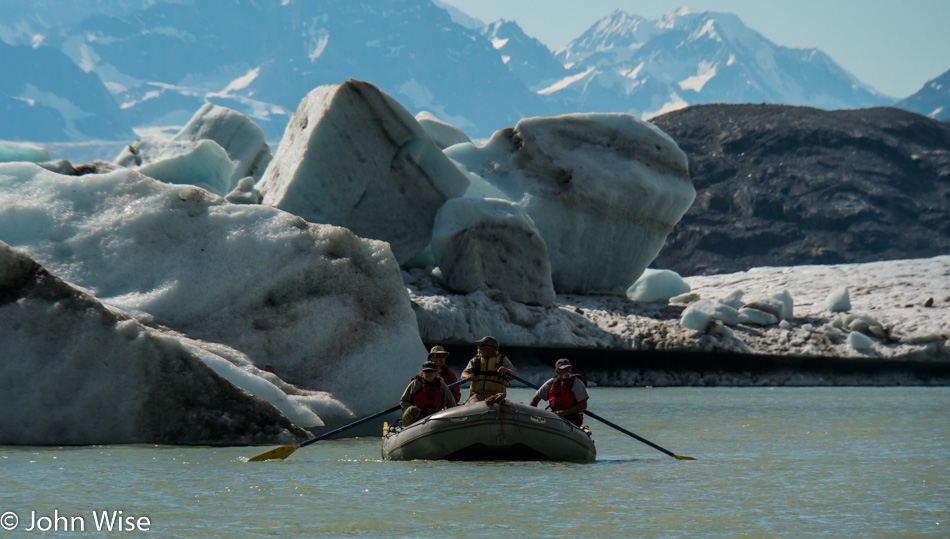
That’s our boatman Thirsty on the oars, and now, with some human artifacts in front of the icebergs, you can get an idea of the scale of stuff that we are looking at. The rock on the right is that nunatak again, and my pictures from five years ago show the glacier higher than this nunatak with the glacier wrapping around the front of it. This all makes me wonder if, within my lifetime a rafter might come through here and be lucky to even see snow on the mountains in July.
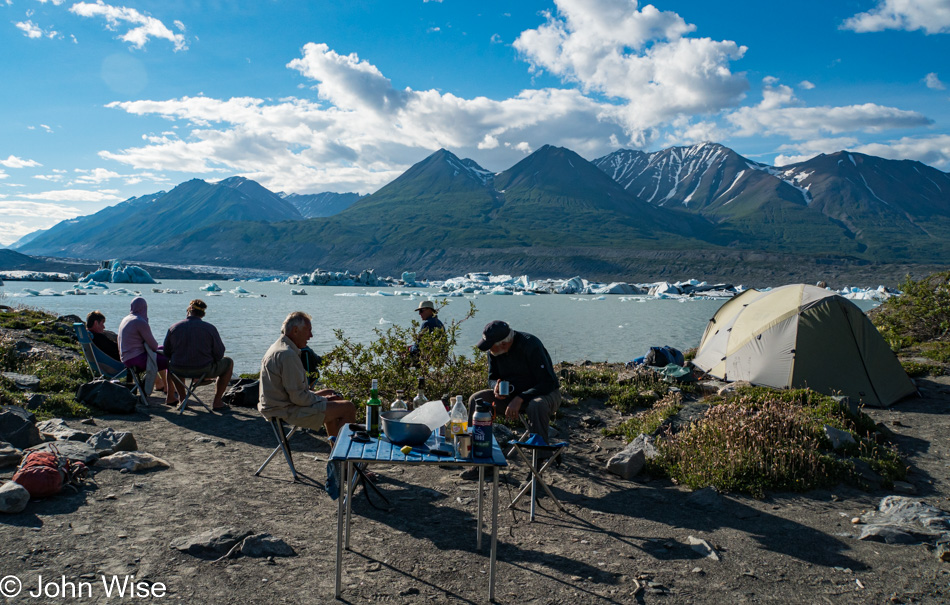
Back in camp, nothing to do but wait for dinner and hang out. It’s not a bad life being an adventure traveler.
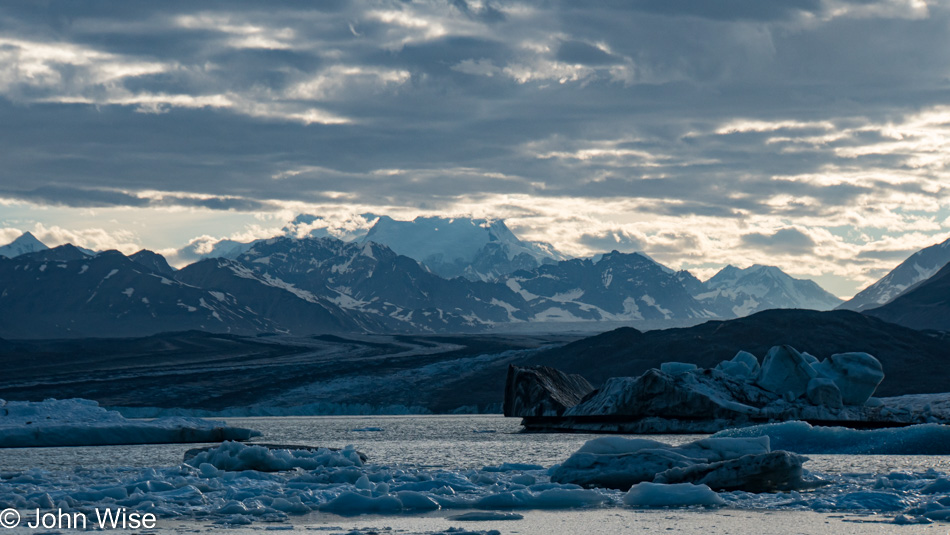
After three days out here, it was probably polite of us to dip below the skivvy line for some proper de-stinkification therapy. So we slunk off to our personal tent front pond instead of the lake with all the bobbing water chilling iceberg chunks; the only problem with our much warmer water is that the mud oozing between the toes has a distinct fecal kind of feel. Through our team effort, we were soon squeaky clean, feeling like a million tiny sparkly iceberg bits shining in the sun.
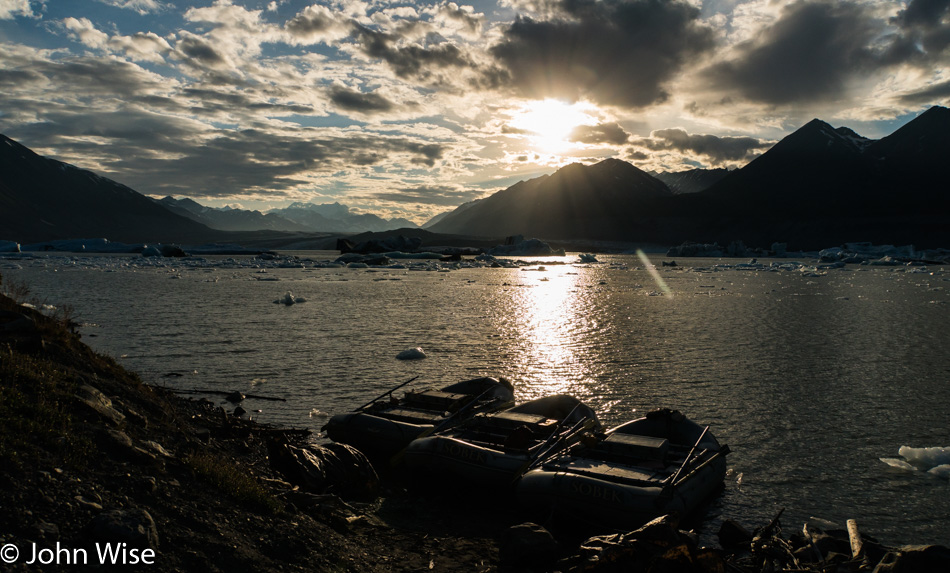
Tonight’s entertainment was brought to us by Mother Nature, who was parading a cavalcade of ice driven by the wind right past us. In the background stood Mount Kennedy, holding vigil over the sky to ensure that everything that could look perfect did so. From the calving glacier and rolling icebergs rumbles, thunder, and heavy claps sounding like gunshots travel over the lake to complement the lapping waves at the shore. The whole time, the glistening water surface forces us to squint to find details in the blinding evening sun. As our sun slides westward, its changing intensity illuminates the bergs in shifting colors that move from opaque blues to greens while the thicker slabs look like city blocks of snowpack where no light passes through. Like clouds in the sky the various forms the ice takes shift from appearing like a Christmas tree to an anvil or the Loch Ness Monster. Then we spot two dolphins leaping out of the water, a swimming bear holding on to a ball, and even a body lying down; alas, it was all ice.
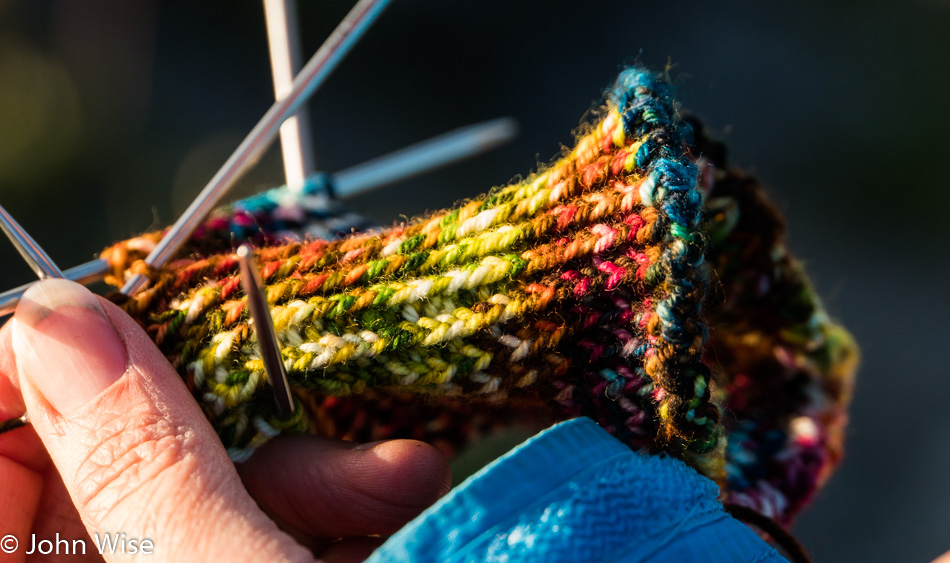
I’m guessing it’s getting late, though it’s hard to tell as the sun simply slides lower across the horizon. On my right, Caroline is knitting my next pair of socks. She has a needle in her mouth, her face is golden and a little bit burned. Her nimble fingers knit and purl, and occasionally, she smiles as she listens in with half an ear on the ribald conversation of some of the guys who have had a few drinks and are hanging out by the fire.
While it was downright hot earlier the chill of the evening combined with the wind coming off the glacier and lake in front of it has us bundling up in some warm clothes. The first yawn of the night just escaped Caroline as she announced it was time to find the motivation to go move her own water. Minutes later, we are asleep.